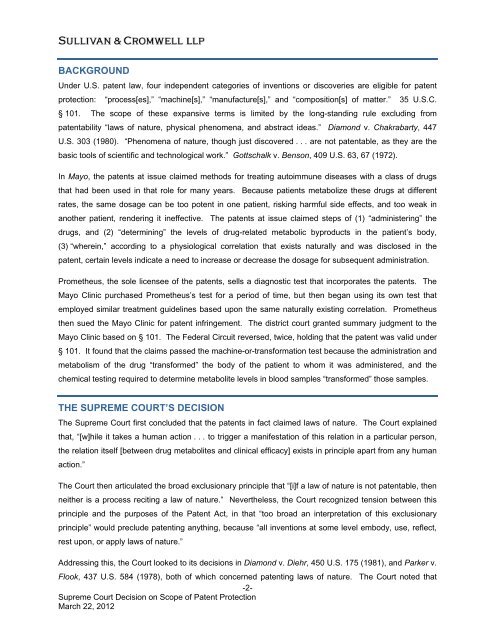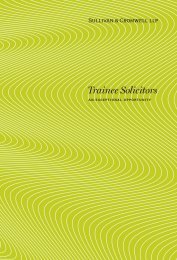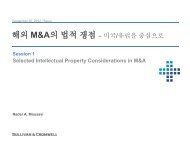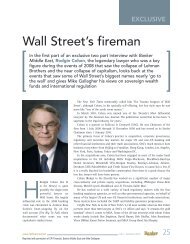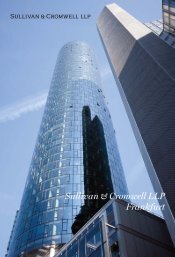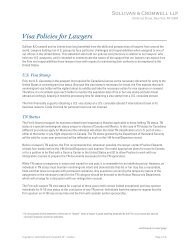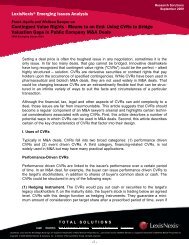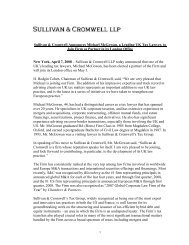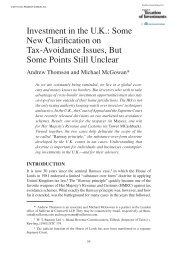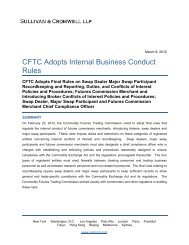Supreme Court Decision on Scope of Patent Protection - Sullivan ...
Supreme Court Decision on Scope of Patent Protection - Sullivan ...
Supreme Court Decision on Scope of Patent Protection - Sullivan ...
You also want an ePaper? Increase the reach of your titles
YUMPU automatically turns print PDFs into web optimized ePapers that Google loves.
BACKGROUND<br />
Under U.S. patent law, four independent categories <strong>of</strong> inventi<strong>on</strong>s or discoveries are eligible for patent<br />
protecti<strong>on</strong>: “process[es],” “machine[s],” “manufacture[s],” and “compositi<strong>on</strong>[s] <strong>of</strong> matter.” 35 U.S.C.<br />
§ 101. The scope <strong>of</strong> these expansive terms is limited by the l<strong>on</strong>g-standing rule excluding from<br />
patentability “laws <strong>of</strong> nature, physical phenomena, and abstract ideas.” Diam<strong>on</strong>d v. Chakrabarty, 447<br />
U.S. 303 (1980). “Phenomena <strong>of</strong> nature, though just discovered . . . are not patentable, as they are the<br />
basic tools <strong>of</strong> scientific and technological work.” Gottschalk v. Bens<strong>on</strong>, 409 U.S. 63, 67 (1972).<br />
In Mayo, the patents at issue claimed methods for treating autoimmune diseases with a class <strong>of</strong> drugs<br />
that had been used in that role for many years. Because patients metabolize these drugs at different<br />
rates, the same dosage can be too potent in <strong>on</strong>e patient, risking harmful side effects, and too weak in<br />
another patient, rendering it ineffective. The patents at issue claimed steps <strong>of</strong> (1) “administering” the<br />
drugs, and (2) “determining” the levels <strong>of</strong> drug-related metabolic byproducts in the patient’s body,<br />
(3) “wherein,” according to a physiological correlati<strong>on</strong> that exists naturally and was disclosed in the<br />
patent, certain levels indicate a need to increase or decrease the dosage for subsequent administrati<strong>on</strong>.<br />
Prometheus, the sole licensee <strong>of</strong> the patents, sells a diagnostic test that incorporates the patents. The<br />
Mayo Clinic purchased Prometheus’s test for a period <strong>of</strong> time, but then began using its own test that<br />
employed similar treatment guidelines based up<strong>on</strong> the same naturally existing correlati<strong>on</strong>. Prometheus<br />
then sued the Mayo Clinic for patent infringement. The district court granted summary judgment to the<br />
Mayo Clinic based <strong>on</strong> § 101. The Federal Circuit reversed, twice, holding that the patent was valid under<br />
§ 101. It found that the claims passed the machine-or-transformati<strong>on</strong> test because the administrati<strong>on</strong> and<br />
metabolism <strong>of</strong> the drug “transformed” the body <strong>of</strong> the patient to whom it was administered, and the<br />
chemical testing required to determine metabolite levels in blood samples “transformed” those samples.<br />
THE SUPREME COURT’S DECISION<br />
The <str<strong>on</strong>g>Supreme</str<strong>on</strong>g> <str<strong>on</strong>g>Court</str<strong>on</strong>g> first c<strong>on</strong>cluded that the patents in fact claimed laws <strong>of</strong> nature. The <str<strong>on</strong>g>Court</str<strong>on</strong>g> explained<br />
that, “[w]hile it takes a human acti<strong>on</strong> . . . to trigger a manifestati<strong>on</strong> <strong>of</strong> this relati<strong>on</strong> in a particular pers<strong>on</strong>,<br />
the relati<strong>on</strong> itself [between drug metabolites and clinical efficacy] exists in principle apart from any human<br />
acti<strong>on</strong>.”<br />
The <str<strong>on</strong>g>Court</str<strong>on</strong>g> then articulated the broad exclusi<strong>on</strong>ary principle that “[i]f a law <strong>of</strong> nature is not patentable, then<br />
neither is a process reciting a law <strong>of</strong> nature.” Nevertheless, the <str<strong>on</strong>g>Court</str<strong>on</strong>g> recognized tensi<strong>on</strong> between this<br />
principle and the purposes <strong>of</strong> the <strong>Patent</strong> Act, in that “too broad an interpretati<strong>on</strong> <strong>of</strong> this exclusi<strong>on</strong>ary<br />
principle” would preclude patenting anything, because “all inventi<strong>on</strong>s at some level embody, use, reflect,<br />
rest up<strong>on</strong>, or apply laws <strong>of</strong> nature.”<br />
Addressing this, the <str<strong>on</strong>g>Court</str<strong>on</strong>g> looked to its decisi<strong>on</strong>s in Diam<strong>on</strong>d v. Diehr, 450 U.S. 175 (1981), and Parker v.<br />
Flook, 437 U.S. 584 (1978), both <strong>of</strong> which c<strong>on</strong>cerned patenting laws <strong>of</strong> nature. The <str<strong>on</strong>g>Court</str<strong>on</strong>g> noted that<br />
-2-<br />
<str<strong>on</strong>g>Supreme</str<strong>on</strong>g> <str<strong>on</strong>g>Court</str<strong>on</strong>g> <str<strong>on</strong>g>Decisi<strong>on</strong></str<strong>on</strong>g> <strong>on</strong> <strong>Scope</strong> <strong>of</strong> <strong>Patent</strong> Protecti<strong>on</strong><br />
March 22, 2012


